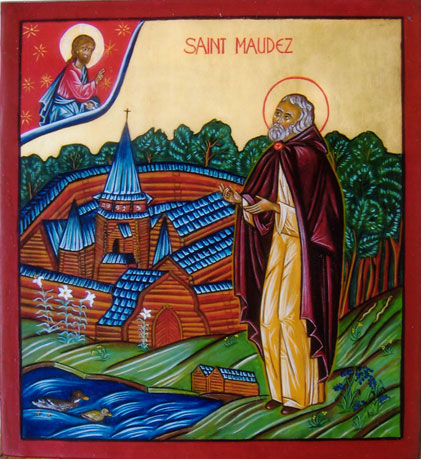St.
Mawes - The Welsh hermit and abbot Maudetus, known in
France as St. Maudez, lived the eremitical life in Cornwall,
near Falmouth, where he is revered to this day. Afterwards
he dwelt upon an island off the Breton coast. A monastic
founder, he established monasteries and churches of the
Orthodox Faith in Cornwall and in Brittany.
The lives
of the 6th century Irish saints frequently contain startling
elements, and that of Saint Mawes is no exception. Even his
birth was remarkable. His mother was called Azenor and lived
in Brittany. One day she was thrown into the sea near Brest,
with only a barrel for a boat. There Mawes was born. Mother
and son stayed in the cask for five months, till they were
washed up alive on the coast of Ireland.
(This is the same birth story as Saint Budoc (Beuzec; f.d.
December 8). Budoc's name is associated with Mawes, no doubt
they were both missionary monks of Welsh origin, who founded
monasteries in Cornwall and Brittany, perhaps at Dol.)
He moved from Ireland as an adult to live as a hermit near
Falmouth in Cornwall, thus founding a fishing village of
which he is the patron. Then, in the days of King Childbert
I, Saint Mawes decided to return to the land of his mother.
On his way to Brittany, he visited Devon and Cornwall,
preaching outdoors and founding a town on the River Fal
named after him.
Then he and his followers sailed for Brittany. Landing on an
island just off the coast of France near Leon, Ile Modez (Maudez),
the saint showed his skill by clearing it of vermin, setting
fire to the dried vegetation to do this. He also gained a
reputation as a fine teacher. Many churches in the region
are dedicated to him--testifying to his influence and
missionary zeal.
One reason for Saint Mawe's return to Brittany is said to
have been to escape yellow fever in Ireland. He subsequently
became famed for his ability to cure many kinds of sickness.
After his death, the earth under which he was buried was
often taken away, mixed with water and used as medicine.
The saint eventually established a monastic community on
Saint Maudez Island. One day the last fire on the island was
accidentally extinguished. Mawes sent a serving boy at low
tide to cross to the mainland and bring back a flame. As the
boy set off back, the tide came in. The waves rose higher
and higher, threatening to engulf the flame; but the boy
stood on a rock, prayed to Saint Mawes, and discovered the
rock rising miraculously so that it never sank beneath the
sea. When the tide went out again, the flame was
successfully transported to Saint Maudez (Attwater,
Benedictines, Bentley, D'Arcy, Encyclopaedia, Farmer).
In art Saint Mawes is portrayed as a schoolmaster (according
to Leland). He is venerated at Falmouth and in Brittany
(Roeder), where 60 churches and chapels are named after him.
The relics of Saint Mawes are venerated at Quimper, Treguier,
Lesneven, and Bourges (which claims his body). He is invoked
against headache, worms, and snake bite (Farmer).
Troparion of St Mawes - tone 8
Despite thy royal birth thou
didst embrace the monastic life in infancy,
O Father Mawes, boast of ascetics and banisher of snakes./
As we are
blessed to have thy precious relics with us to this day,/
pray O Saint,
that we may be worthy of Christ's mercy and that our souls
may be saved.

